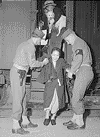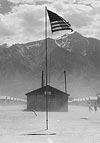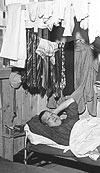| 1940 |
| |
The
U.S. Census reports that 126,947 Japanese lived in the United
States, sixty percent of them native born citizens. Nine out
of ten lived in three Pacific coast states, three-quarters
in California. Another 150,000 people of Japanese ancestry
live in Hawaii, amounting to 37 percent of the population.
Almost 80 percent were native born. |
1941 |
Aug.
18 |
In
a letter to President Roosevelt, Representative John Dingell
of Michigan suggests incarcerating 10,000 Hawaiian Japanese
Americans as hostages to ensure "good behavior"
on the part of Japan. |
Nov.
12 |
Fifteen Japanese American businessmen and community leaders
in Los Angeles Little Tokyo are picked up in an F.B.I. raid.
A spokesman for the Central Japanese Association states: "We
teach the fundamental principles of America and the high ideals
of American democracy. We want to live here in peace and harmony.
Our people are 100% loyal to America." |
Dec.
7 |
Japan
attacks the American naval base at Pearl Harbor, Hawaii and
American military facilities in the Philippines, Guam, and
Midway Island. |
Dec.
8 |
The
United States declares war on Japan.
|

Frank
Biddle became Attorney General in September, 1941
|
The
Attorney General announces that the FBI is detaining a select
group of Japanese aliens who are regarded as “dangerous
to the peace and security” of the nation.
He
states that only a small number of Japanese aliens would
be arrested and warned against a tendency to consider all
Japanese aliens in the United States as enemies.
By
Dec. 11, 1941, 1200 Japanese aliens had been arrested. |
|
The
government closes the United States’s borders to all
enemy aliens and to all people of Japanese ancestry, whether
alien or citizen. |
Dec.
11 |
The
Army creates the Western Defense Command, which is given the
responsibility of defending the Pacific Coast of the United
States. |
Dec.
30 |
The
Attorney General of the United States authorizes raids without
a search warrant on the homes of people of Japanese descent
provided that at least one resident is a Japanese alien. |
| 1942 |
Jan.
28 |
The
Roberts Commission report about the Pearl Harbor attack alleges
without documentation that espionage agents in Hawaii, including
Japanese-American citizens, helped the Japanese naval force
that attacked Pearl Harbor. |
Feb.
10

Henry Stimson
|
Secretary
of War Henry Stimson writes in his diary: "The second
generation Japanese can only be evacuated either as part
of a total evacuation, giving access to the areas only by
permits, or by frankly trying to put them out on the ground
that their racial characteristics are such that we cannot
understand or even trust the citizen Japanese. This latter
is the fact but I am afraid it will make a tremendous hole
in our constitutional system to apply it."
Attorney
General Francis Biddle is advised by agency lawyers that
removal of people of Japanese descent from Pacific Coast
areas would be a legal exercise of the President's war powers.
|
Feb.
11 |
Secretary
of War Henry Stimson calls President Roosevelt and recommends
the mass evacuation of people of Japanese descent from the
Pacific Coast area. Roosevelt tells Stimson to do whatever
he believes is necessary. |
Feb.
12 |
Columnist
Walter Lippmann publishes a nationally syndicated column in
which he says, "The Pacific Coast is in imminent danger
of a combined attack from within and from without". The
Japanese navy has been reconnoitering the coast more or less
continuously. The Pacific Coast is officially a combat zone;
some part of it may at any moment be a battlefield. Nobody's
constitutional rights include the right to reside and do business
on a battlefield. And nobody ought to be on a battlefield
who has no good reason for being there." |
Feb.
13 |
Members
of Congress from the Pacific Coast send President Roosevelt
a letter in which they recommend the "immediate evacuation
of all persons of Japanese lineage" aliens and citizens
alike from the entire strategic area of California, Washington,
and Oregon. |
Feb.
14 |
The
U. S. Army’s Western Defense Command sends a memorandum
to the Secretary of War recommending the evacuation of “Japanese
and other subversive persons” from the Pacific Coast
area. |
Feb.
19 |
President
Franklin D. Roosevelt issues Executive Order 9066,
which empowers the Secretary of War or any military commander
authorized by him to designate “military areas”
and exclude “any and all persons” from them. Shortly
before signing the Executive Order, the President received
a memorandum from his advisers which said, “In time
of national peril, any reasonable doubt must be resolved in
favor of action to preserve the national safety, not for the
purpose of punishing those whose liberty may be temporarily
affected by such action, but for the purpose of protecting
the freedom of the nation, which may be long impaired, if
not permanently lost, by nonaction.” |
Feb.
23 |
A
Japanese submarine shells an oil refinery near Santa Barbara,
California, causing little damage. A submarine launched aircraft
dropped two incendiary bombs in the forest near Brookings,
Oregon on Sept. 9, 1942, and another two bombs were dropped
by the same aircraft in the Oregon forest about three weeks
later. Neither bombing caused significant damage. These four
incidents are the only authenticated Japanese attacks on the
American mainland during World War II. |
Feb.
25 |
The
Navy informs Japanese American residents of Terminal Island
near Los Angeles Harbor that they must leave in 48 hours.
They are the first group to be removed en masse. |
Feb.
27 |
Idaho
Governor Chase Clark tells a congressional committee in Seattle
that Japanese would be welcome in Idaho only if they were
in "concentration camps under military guard. |
Mar.
2 |
The
Western Defense Command issues a proclamation which designates
the western halves of California, Oregon, and Washington,
and the southern third of Arizona as a military area and states
that all persons of Japanese descent are to be removed from
this area. |
Mar.
18 |
President
Franklin D. Roosevelt issues Executive Order 9102, which establishes
the War Relocation Authority (WRA) within the Department for
Emergency Management. The WRA is empowered “to provide
for the removal from designated areas of persons whose removal
is necessary in the interests of national security….”
The WRA is further empowered to provide for evacuees’
relocation and their needs, to supervise their activities,
and to provide for their useful employment. Milton S. Eisenhower
is named director of the WRA. |
Mar.
21 |
President
Roosevelt signs Public Law 77-503, which makes it a federal
crime for a person ordered to leave a military area to refuse
to do so. |
Mar.
22

|
The
first removal of people of Japanese descent from the designated
Pacific Coast area occurs. The people are from the Los Angeles
area; they are sent to the Manzanar relocation center in northeastern
California. The center comprises a 6000 acre site, enclosed
by barbed wire fencing, and within that site a 560 acre residential
site with guard towers, search lights, and machine gun installations.
During the next eighteen months, about 120,000 people of Japanese
descent are removed from the Pacific Coast area to ten relocation
centers in California, Arizona, Idaho, Wyoming, Colorado,
Utah, and Arkansas. |
Mar.
24 |
The
first Civilian Exclusion Order issued by the Army is issued
for the Bainbridge Island area near Seattle. The forty-five
families there are given one week to prepare. By the end of
Oct., 108 exclusion orders would be issued, and all Japanese
Americans in Military Area No. 1 and the California portion
of No. 2 would be incarcerated. |
Mar.
27 to 30 |
The
Western Defense Command issues proclamations which severely
restrict the movements of persons of Japanese descent in the
Pacific Coast military area, and which prohibit them from
leaving the military area. |
|
|
Mar.
28 |
Minoru
Yasui walks into a Portland police station at 11:20 p.m. to
present himself for arrest in order to test the curfew regulations
in court. |
Apr.
7

|
A
meeting of WRA officials with representatives of eleven western
states convenes in Salt Lake City, Utah. The representatives
for the most part express distrust of and dislike for the
people of Japanese descent who were being evacuated to their
states. The WRA concludes that, because of this hostile local
opinion, the evacuees from the Pacific Coast must be housed
in evacuation camps guarded by the Army. During the meeting,
the governor of Wyoming told the director of the WRA, “If
you bring Japanese into my state, I promise you they will
be hanging from every tree.” |
May
13 |
Forty-five-year-old
Ichiro Shimoda, a Los Angeles gardener who is mentally ill,
is shot to death by guards while trying to escape from Fort
Still (Oklahoma) internment camp |
May
16 |
Hikoji
Takeuchi, a Nisei, is shot and wounded by a guard at Manzanar |
Spring |
WRA
administrators divide the people of Japanese descent in the
Pacific Coast military zone into three categories: (1) Issei,
immigrant Japanese born in Japan (about 40,000 in the military
zone); (2) Nisei, American born and educated children of Issei
parents (about 63,000 in the military zone); and (3) Kibei,
American born but educated wholly or partly in Japan (about
9,000 in the military zone). A fourth category was Sansei,
second generation American born, the children of the Nisei
(about 4,500 in the military zone). |
Spring |
The
WRA begins releasing college students, agricultural laborers,
and linguists from the relocation centers on a temporary basis.
|
June |
The
movie "Little Tokyo, U.S.A.," released by Twentieth
Century Fox, portrays Japanese Americans as a "vast army
of volunteer spies" and "blind worshippers of their
Emperor.” |
June
17 |
Dillon
S. Myer is named director of the WRA, succeeding Milton S.
Eisenhower. Myer served as director until the agency’s
program is shut down in 1946. |
June
21 |
A
Japanese submarine shells the Oregon coast, causing little
damage. |
July
27 |
Two
Issei -- Brawley, CA farmer Toshiro Kobata and San Pedro fisherman
Hirota Isomura -- are shot to death by camp guards at Lourdsburg,
New Mexico enemy alien internment camp |
Aug.
4 |
A
routine search for contraband at the Santa Anita "Assembly
Center" turns into a riot. |
Aug.
7 |
The
Western Defense Command announces the completion of its removal
of people of Japanese descent from the Pacific Coast military
area. |
|
The
WRA decides that its purpose must be to resettle the evacuees
in new homes well outside the Pacific Coast military area,
not to detain them indefinitely in the relocation centers.
By the end of 1944, about 30,000 evacuees had been resettled
in new homes, primarily in states such as Illinois, Colorado,
Ohio, Utah, Idaho, Michigan, Minnesota, and New York. |
Nov.
14 |
An
attack on a man considered an informer results in the arrest
of two popular inmates at Poston and mushrooms into a mass
strike. |
Dec.
5 |
After
Fred Tayama is attacked by a group of inmates at Manzanar,
the arrest of Harry Ueno for the crime triggers a mass uprising. |
| 1943 |
Winter |
The
number of evacuees at relocation centers peaks at about 107,000. |
Feb.
1 |
The
442nd Regimental Combat Team is activated, made up entirely
of Japanese Americans. |
Mar.
11 |
The
director of the WRA sends a letter to the Secretary of War
in which he recommends an immediate relaxation of the exclusion
order against persons of Japanese descent. In a letter of
May 10, 1943, the Secretary of War said he would not consider
the WRA director’s recommendation until the “vicious,
well-organized, pro-Japanese minority group[s]” were
removed from the relocation centers. |
Apr.
11 |
James
Hatsuki Wakasa, a sixty-three-year-old chef, is shot to death
by a sentry at Heart Mountain camp while allegedly trying
to escape through a fence |
May
14

|
Dillon
S. Myer, director of the War Relocation Authority, issues
a statement which says that the relocation centers:
“are undesirable institutions and should be removed
from the American scene as soon as possible. Life in a
relocation center is an unnatural and un-American sort
of life. Keep in mind that the evacuees were charged with
nothing except having Japanese ancestors; yet the very
fact of their confinement in relocation centers fosters
suspicion of their loyalties and adds to their discouragement.
It has added weight to the contentions of the enemy [the
Empire of Japan] that we are fighting a race war-that
this nation preaches democracy and practices racial discrimination.”
|
June |
The
United States Supreme Court rules unanimously in Hirabayashi
v. United States that a Japanese-American citizen must obey
the curfew regulations promulgated by the Western Defense
Command. One of the concurring opinions notes that “Today
is the first time, so far as I am aware, that we have sustained
a substantial restriction of the personal liberty of citizens
of the United States based on the accident or race or ancestry….
It bears a melancholy resemblance to the treatment accorded
to [Jews] in Germany.” |
Ca.
June |
The
Tule Lake relocation center is selected as the place where
evacuees perceived to be loyal to Japan rather than to the
United States, often on very imperfect evidence, are to be
segregated. About 9,000 evacuees were moved to Tule Lake from
the other nine relocation centers in Sept. and Oct., 1943.
The center eventually housed about 18,000 evacuees. |
Nov.4 |
An
uprising at Tule Lake caps a month of strife. Tension had
been high since the administration had fired 43 coal workers
involved in a labor dispute on Oct. 7. |
| 1944 |
Jan.
1 |
The
number of evacuees at relocation centers is about 93,000. |
Jan.
14 |
Nisei
eligibility for the draft is restored. |
Jan.
26 |
At
Heart Mountain camp, the Fair Play Committee is formally organized
to support draft resistance. |
Feb.
16 |
President
Franklin D. Roosevelt issues Executive Order 9423, transferring
the WRA from the Office for Emergency Management to the Department
of the Interior in response to disturbances on Nov. 1 through
4 at the Tule Lake segregation center. |
Mar.
20 |
Forty-three
Japanese American soldiers are arrested for refusing to participate
in combat training at Fort McClellan, Alabama, as a protest
of treatment of their families in U.S. camps. Eventually,
106 are arrested for their refusal. Twenty-one are convicted
and serve prison time before being paroled in 1946. |
May
10 |
A
Federal Grand Jury issues indictments against 63 Heart Mountain
draft resistors. The 63 are found guilty and sentenced to
jail terms on June 26. They would be granted a pardon on Dec.
24, 1947. |
May
24 |
Shoichi
James Okamoto is shot to death at Tule Lake. |
June
30 |
The
first of the ten relocation centers is closed. |
July
1 |
President
Roosevelt signs Public Law 78-405, called the Denaturalization
Act of 1944, which creates a procedure whereby American citizens
may lose their citizenship in time or war by renouncing it
in writing. In late 1944 and early 1945, about 5,500 evacuees
at the Tule Lake segregation center made application to renounce
their American citizenship under the provisions of Public
Law 78-405. |
July
21 |
Seven
members of the Heart Mountain Fair Play Committee are arrested,
along with journalist James Omura. Their trial for "unlawful
conspiracy to counsel, aid and abet violators of the draft"
begins on Oct. 23. All but Omura would eventually be found
guilty. |
Nov.
21 |
President
Roosevelt says at a press conference that “a good deal
of progress has been made in scattering [evacuees] through
the country, and that is going on every day…. The example
I always cite…is the…county…in [which] probably
half a dozen or a dozen families could be scattered around
on the farms and worked into the community.” |
Dec.
18 |
The
director of the WRA announces that all relocation centers
will be closed by the end of 1945, and that the WRA’s
operations will be ended by June 30, 1946. |
Dec.
18 |
In
Korematsu vs. United States, the Supreme Court upholds the
constitutionality of Executive Order 9066, which authorized
the removal of people from certain areas by the Secretary
of War or military commanders designated by him. The court
finds the Executive Order and the actions it authorizes to
be a constitutional exercise of the President’s war
powers. |
|
In
Ex Parte Endo, issued the same day, the court rules that Executive
Orders 9066 and 9102 cannot be construed to give the WRA “authority
to subject citizens who are concededly loyal” to detention
in a relocation center. |
| 1945 |
Jan.
1 |
The
number of evacuees at relocation centers is about 80,000.
|
Jan.
8 |
The
packing shed of the Doi family is burned and dynamited and
shots are fired into their home. The family had been the first
to return to California from Amache and the first to return
to Placer County, having arrived three days earlier. Although
several men are arrested and confess to the acts, all would
be acquitted. Some 30 similar incidents would greet other
Japanese Americans returning to the West Coast between Jan.
and June. |
May
14 |
The
Secretary of the Interior publicly denounces violent intimidation
of Japanese Americans. |
July
13 |
The
director of the WRA announces that all relocation centers,
except the one at Tule Lake, California, will be closed on
scheduled dates between Oct. 15 and Dec. 15, 1945. |
Aug.
1 |
The
number of evacuees at relocation centers is about 58,000. |
Aug.
14 |
Japan
surrenders. Japan signed the formal instrument of surrender
on Sept. 2, 1945. |
Sept.
4 |
The
Western Defense Command issues a proclamation revoking all
exclusion orders and military restrictions against persons
of Japanese descent. |
Oct.
and Nov., 1945 |
Eight
of the remaining nine relocation centers close. |
Dec.
1 |
The
number of evacuees at the Tule Lake segregation center, the
last of the WRA centers to remain in operation, is about 12,500. |
| 1946 |
Mar.
20 |
The
Tule Lake segregation center is closed. About half of all
evacuees released from the relocation centers returned to
the Pacific Coast area; most of the remainder settled in other
parts of the country. |
Apr.
24 |
The
Truman administration sends to Congress proposed legislation
which would establish an Evacuation Claims Commission to adjudicate
claims against the United States for losses suffered by evacuees
as a result of their removal from their homes and detention
in relocation centers. |
June
26 |
President
Harry S. Truman signs Executive Order 9742, which terminates
the WRA effective June 30, 1946. |
July
15 |
The
442nd Regimental Combat Team is received on the White House
lawn by President Truman. "You fought not only the enemy
but you fought prejudice -- and you have won," remarks
the president. |
| 1948 |
1948 |
In
Oyama v. California, the Supreme Court struck down the Alien
Land Laws as violations of the Fourteenth Amendment. The Evacuation
Claims Act authorized payment to Japanese Americans who suffered
economic loss during imprisonment: with the necessary proof,
10 cents was returned for every $1.00 lost |
Feb.
2 |
President
Truman sends to Congress a special message on civil rights
in which he requests legislation to settle claims against
the government by the 110,000 people of Japanese descent who
were evacuated from their homes during World War II. |
July
2 |
President
Truman signs the Japanese-American Claims Act, which authorizes
the settlement of property loss claims by people of Japanese
descent who were removed from the Pacific Coast area during
World War II. According to a Senate Report about the act,
“The question of whether the evacuation of the Japanese
people from the West Coast was justified is now moot. The
government did move these people, bodily, the resulting loss
was great, and the principles of justice and responsible government
require that there should be compensation for such losses.”
The Congress over time appropriated $38 million to settle
23,000 claims for damages totaling $131 million. The final
claim was adjudicated in 1965. |
| 1950 |
Sept.
23 |
Congress
passes, over President Truman’s veto, Public Law 81-831,
which includes the Emergency Detention Act of 1950. This act
authorizes the implementation of procedures, modeled on those
used to incarcerate people of Japanese descent during World
War II, which would be used against those, assumed to be Communists
or Communist sympathizers, who might commit acts of espionage
or sabotage in time or war or national emergency. Congress
repealed this law in 1971. |
| 1976 |
Feb.
19 |
President
Gerald R. Ford issues Proclamation 4417, titled “An
American Promise,” on the 34th anniversary of the issuance
of Executive Order 9066, which had authorized the removal
of people from designated military areas. “I call upon
the American people to affirm with me this American Promise,”
President Ford’s proclamation reads, “that we
have learned from the tragedy of that long-ago experience
forever to treasure liberty and justice for each individual
American, and resolve that this kind of action shall never
again be repeated.” |
| 1983 |
Early |
A
government report Personal
Justice Denied concludes, “The promulgation
of Executive Order 9066 was not justified by military necessity,
and the decisions which followed from it…were not driven
by analysis of military conditions. The broad historical causes
which shaped these decisions were race prejudice, war hysteria
and a failure of political leadership. Widespread ignorance
of Japanese Americans contributed to a policy conceived in
haste and executed in an atmosphere of fear and anger at Japan.
A grave injustice was done to Americans and resident aliens
of Japanese ancestry who…were excluded, removed and
detained by the United States during World War II.”
The report recommends, among other things, that Congress apologize
to the evacuees and that the United States make a tax-free
payment of $20,000 to each surviving evacuee. |
|
1987 |
Aug.
10 |
President
Ronald Reagan signs the Civil Rights Act of 1988, which includes
a provision for payments of $20,000 each to surviving Japanese
Americans who had been incarcerated because of their ethnicity
during World War II. Japanese Americans referred to these
payments as “redress” for the wrongs they suffered.
|
| 1990 |
Oct.
9 |
Attorney
General Richard Thornburgh, in a ceremony at the Justice Department
in Washington, DC, presents the first payments to Japanese
Americans under the provisions of the Civil Rights Act of
1988. “Your struggle for Redress and the events that
led to today,” the Attorney General said, “are
the finest examples of what our country is about, and of what
I have pledged to protect and defend, for your efforts have
strengthened the nation’s Constitution by reaffirming
the inalienability of our civil rights.” |
| |
President
Bill Clinton bestows the Presidential Medal of Freedom on
Fred Korematsu, the plaintiff in Korematsu vs. United States
(1944), in which the Supreme Court upheld the constitutionality
of the government’s removal of people of Japanese descent
from the Pacific Coast military zone. Korematsu’s conviction
had been overturned in 1984 because the government’s
evidence was determined to be tainted. |